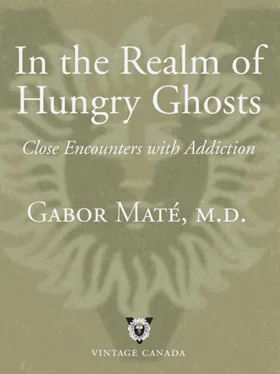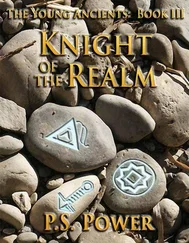As the stories of Serena, Celia and Angela in the first part of this book illustrate, many women who become injection drug users were severely abused in childhood—the vast majority, according to the research. Of those three women, two are Native. It is a fact that over the past several generations Native female children in Canada have been more likely to suffer sexual abuse in their families of origin than non-Natives. That this is so says nothing about the “innate” nature of Canadian Native peoples. Sexual abuse of young children among tribal peoples living in their natural habitats is virtually nonexistent, and so it was with North American Natives before European colonization. The current dismal statistics say everything about the relationship of Aboriginal societies to the dominant culture.
The precursor to addiction is dislocation, according to Bruce Alexander, professor of psychology at Simon Fraser University. By dislocation he means the loss of psychological, social and economic integration into family and culture; a sense of exclusion, isolation and powerlessness. “Only chronically and severely dislocated people are vulnerable to addiction,” he writes.
The historical correlation between severe dislocation and addiction is strong. Although alcohol consumption and drunkenness on festive occasions was widespread in Europe during the Middle Ages, and although a few people became “inebriates” or “drunkards,” mass alcoholism was not a problem. However, alcoholism gradually spread with the beginnings of free markets after 1500, and eventually became a raging epidemic with the dominance of the free market society after 1800. 14
Dr. Dupont agrees that in premodern societies, although substance use to the point of intoxication was permitted, “that use was infrequent and managed in families and communities…Stable communities in premodern times were the Golden Age for alcohol and drug use.” 15
With the rise of industrial societies came dislocation: the destruction of traditional relationships, extended family, clan, tribe and village. Vast economic and social changes tore asunder the ties that formerly connected people to those closest to them and to their communities. They displaced people from their homes and shredded the value systems that secured people’s sense of belonging in the moral and spiritual universe. The same process is happening around the world as a result of globalization. China is a prime example. That country’s breakneck-speed industrialization has made it an emerging economic superpower, but the accompanying social dislocation is likely to prove disastrous. Entire villages and towns are being depopulated to make room for megaprojects like the Three Gorges Dam. The pressures of urbanization are cutting millions of people adrift from their connections with land, tradition and community. The social and psychological results of massive dislocation are not only predictable; they’re already obvious. China has had to set up a massive needle-exchange program in an attempt to prevent the spread of HIV and other infectious diseases among its rapidly burgeoning addict population. According to the Ministry of Health in Beijing, nearly half of China’s estimated 650,000 people living with HIV/AIDS are drug users who contracted the disease by sharing needles. 16There can be no doubt that the ravages of social breakdown—alienation, violence and addiction—will soon make vast and urgent claims on the attention and resources of Chinese authorities, academics and health professionals. In the rush to emulate the Western world’s achievements, many countries are neglecting to learn from the disruptions, dysfunctions and diseases Western social models engender. *20
Of all the groups affected by the forces of dislocation none have been worse hit than minority populations, such as the Australian Aborigines and North American Native peoples mentioned by Dr. Dupont, and the descendants of black slaves brought to North America. Among the latter, people were separated not only from their places of origin, their cultures and their communities, but often also from their immediate families. Long after the abolition of slavery, racial oppression and prejudice, along with economic deprivation, have continued to produce intolerable pressures on family life among many Afro-Americans—and the link to addiction is obvious. Equally obvious is the enticement of the drug trade to jobless and undereducated young black men excluded from the economic promises of the “American dream.”
The history of dispossession, dislocation, exploitation and direct abuse of Canada’s Native peoples is also too well known to require much discussion. Tobacco and other potentially addictive substances, were available to North American Natives prior to the European invasions, even alcohol in what are now Mexico and the American Southwest—not to mention potentially addictive activities such as sex, eating and gambling. Yet, as Dr. Alexander points out, there is no mention by anthropologists of “anything that could be reasonably called addiction…. Where alcohol was readily available, it was used moderately, often ceremonially rather than addictively.”
With the mass migration of Europeans to North America and the economic transformation of the continent came also the loss of freedom of mobility for Native peoples, the inexorable and still continuing despoliation and destruction of their homelands, the loss of their traditional livelihoods, the invalidation of their spiritual ways, persistent discrimination and abject poverty. Within living memory Native children were seized from their homes, alienated from their families and, for all intents and purposes, incarcerated in “civilizing” institutions where their lot was one of cultural suppression, emotional and physical maltreatment and, with distressing frequency, sexual abuse. It would be heartening to be able to say that our society has acknowledged its enormous historical, moral and economic debt to its Native citizens. Although that has occurred sporadically, the overall pattern continues to be economic dispossession, denial of historical rights and patronizing control. Canada, with our self-appointed “mission” to improve the health, education and well-being of Afghans, has not even come close to securing those same essentials for our First Nations citizens. The living situations, health conditions and social deprivation of many Canadian Natives are abysmal even by Third World standards. Under such circumstances, among tormented, dislocated and, most fundamentally, disempowered people, pain and suffering are transmitted from one traumatized generation to the next. It is no accident that both Serena and her mother live in the same Downtown Eastside hotel on Hastings; nor are they the only mother-daughter Native pairing among my patients. Of any group in North America, whether in the U.S. or Canada, none can be said to be more psychologically and socially oppressed than Native women. 17
Especially since working in the Downtown Eastside, I have often thought that if Canadian society ever apologized to our First Nations people for their dispossession and suffering as we have to Japanese Canadians for their internment during World War II, our contrition would need to be vast and our willingness to make restitution immensely generous. Perhaps that is why we have never accepted the responsibility.

Dislocation continues to be an ever-accelerating feature of modern living, owing to rapid economic and social changes that human culture and human relationships cannot swiftly adapt to. The disruption of family life and the erosion of stable communities afflict many segments of society. Even the nuclear family is under severe pressure with a high divorce rate and single-parent households or, in many cases, two parents having to work outside the home. For these endemic cultural and economic reasons many children today who are not abused and who come from loving homes have lost their primary emotional attachment with the nurturing adults in their lives, with results disastrous for their development. As children become increasingly less connected to adults, they rely more and more on each other—a wholesale cultural subversion of the natural order of things.
Читать дальше













